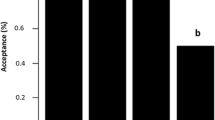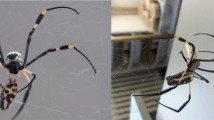Abstract
Predatory behaviour is plastic towards different prey. However, prey differ in their defenses and predators should adjust in order to successfully subdue it. The variation in predatory behaviour could be either innate or developed from experiences. A feasible way to tease these factors apart is by studying inexperienced individuals. Here, I tested if the behaviour of inexperienced predators is different towards two prey types and if it correlates with the behaviour of the prey. I fed naïve spiderlings of the sheet weaver cellar spider Physocyclus globosus (Pholcidae) with either fruit flies or ants as prey (potential extremes in difficulty). I found that, regardless of prey type, individuals that exhibited active defensive behaviour (longer time twisting, moving legs and body segments) elicited a more intense predatory behaviour by the spiderlings (longer time touching and wrapping the prey, and giving more bites). Ants were often more difficult prey than flies, even damaging the spiderling’s leg in five trials. A successful attack to difficult prey was associated with increased handling time of additional silk needed to immobilize it. The differences in the predatory behaviour showed by P. globosus spiderlings suggest plasticity since their first attack. This plasticity would be adaptive for naïve predators of any taxa that encounter a wide diversity of prey.


Similar content being viewed by others
References
Barrantes G, Eberhard WG (2007) The evolution of prey-wrapping behavior in spiders. J Nat Hist 41:1631–1658
Barrantes G, Eberhard WG (2012) Extreme behavioral adjustments by an orb-web spider to restricted spaces. Ethology 118:1–12
Barrantes G, Weng JL (2006) The prey attack behavior of Achaearanea tesselata (Araneae, Theridiidae). J Arachnol 34:456–466
Blamires SJ, Chao I-C, Tso I-M (2010) Prey type, vibrations and handling interactively influence spider silk expression. J Exp Biol 213:3906–3910
Blamires SJ, Chao I-C, Tso I-M (2011) Multiple prey cues induce foraging flexibility in a trap-building predator. Anim Behav 81:955–961
Broom M, Ruxton GD (2005) You can run—or you can hide: optimal strategies for cryptic prey against pursuit predators. Behav Ecol 16:534–540
Brown SG, Christenson TE (1983) The relationship between web parameters and spiderling predatory behavior in the orb-weaver, Nephila clavipes. Z Tierpsychol 63:241–250
Caro T (2005) Antipredator defenses in birds and mammals. University of Chicago Press, Chicago
Clements R, Li D (2005) Regulation and non-toxicity of the spit from the pale spitting spider Scytodes pallida (Araneae: Scytodidae). Ethology 111:311–321
DiRienzo N, Pruitt JN, Hedrick AV (2013) The combined behavioral tendencies of predator and prey mediate the outcome of the interaction. Anim Behav 86:317–322
Eberhard WG (1992) Notes on the ecology and behavior of Physocyclus globosus (Araneae, Pholcidae). Bull Brit Arachnol Soc 9:38–42
Edmunds M (1974) Defence in animals: a survey of anti-predator defences. Longman, Harlow
Edwards GB, Jackson RR (1994) The role of experience in the development of predatory behavior in Phidippius regius, a jumping spider (Araneae, Salticidae) from Florida. N Zeal J Zool 21:269–277
Escalante I (2013) Ontogenetic and sexual differences in exploration and web construction in the spider Physocyclus globosus (Araneae: Pholcidae). Arachnology 16:61–68
Escalante I, Masís-Calvo M (2014) The absence of gumfoot threads in webs of early juveniles and males of Physocyclus globosus (Pholcidae) is not associated with spigot morphology. Arachnology 16:214–218
Escalante I, Aisenberg A, Costa FG (2015) Risky behaviors by the host could favor araneophagy of the spitting spider Scytodes globula on the hacklemesh weaver Metaltella simoni. J Ethol 33:125–136
Forbes LS (1989) Prey defences and predator handling behaviour: the dangerous prey hypothesis. Oikos 55:155–158
Heiling AM, Herberstein ME (1999) The role of experience in web-building spiders (Araneidae). Anim Cogn 2:171–177
Higgins L (2007) Juvenile Nephila (Araneae, Nephilidae) use various attacks strategies for novel prey. J Arachnol 35:530–534
Jakob EM (1991) Costs and benefits of group living for pholcid spiderlings: losing food, saving silk. Anim Behav 41:711–722
Jakob EM (1994) Contests over prey by group-living pholcids (Holocnemus pluchei). J Arachnol 22:39–45
Jakob EM, Skow C, Long S (2011) Plasticity, learning and cognition. In: Herberstein ME (ed) Spider behavior. Flexibility and versatility. Cambridge Univ. Press, New York, pp. 307–347
Japyassú HF, Macagnan CR (2004) Fishing for prey: the evolution of a new predatory tactic among spiders (Araneae, Pholcidae). Rev Etol 6:79–94
Jeschke J, Tollrian R (2000) Density-dependent effects of prey defences. Oecologia 123:391–396
Johnson SA, Jakob EM (1999) Leg autotomy in a spider has minimal costs in competitive ability and development. Anim Behav 57:957–965
Kirchner W, Opderbeck M (1990) Beuteerwerb, giftwirkung und nahrungsaufnahme bei der zitterspinne Pholcus phalangoides (Araneae, Pholcidae). Abhand Verhandlungen des Naturwissenschaftlichen Vereins in Hamburg (NF) 31(32):15–45
Klärner D, Barth FG (1982) Vibratory signals and prey capture in orb-weaving spiders (Zygiella x-notata, Nephila clavipes; Araneidae). J Comp Physiol A 148:445–455
Kosiba S, Allen P, Barrantes G (2012) Feeding effectiveness of Megaphobema mesomelas (Araneae, Theraphosidae) on two prey types. Bull Br Arachnol Soc 15:228–230
Landolfa MA, Barth FG (1996) Vibrations in the orb web of the spider Nephila clavipes: cues for discrimination and orientation. J Comp Physiol A 179:493–508
Líznarová E, Pekár S (2013) Dangerous prey is associated with a type 4 functional response in spiders. Anim Behav 85:1183–1190
Martins-García CR, Japyassú HF (2005) Estereotipia e plasticidade na seqüencia predatória de Theridion evexum Keyserling 1884 (Araneae: Theriididae). Biot Neotrop 5:27–43
Moran MD (2003) Arguments for rejecting the sequential bonferroni in ecological studies. Oikos 100:403–405
Morse DH (2000) The effect of experience on the hunting success of newly emerged spiderlings. Anim Behav 60:827–835
Nakagawa S (2004) A farewell to benferroni: the problem of low statistical power and publication bias. Behav Ecol 15:1044–1045
Nelson XJ, Jackson RR (2011) Flexibility in the foraging strategies of spiders. In: Herbestein ME (ed) Spider behavior. Flexibility and versatility. Cambridge Univ. Press, New York, pp. 38–56
Nentwig W (1983) The prey of web-building spiders compared with feeding experiments (Araneae: Araneidae, Lyniphiidae, Pholcidae, Agelenidae). Oecologia 56:132–139
Nonacs P, Blumstein DT (2010) Predation risk and behavioral life history. In: Westneat DF, Cox CW (eds) Evolutionary behavioral ecology. Oxford University Press, New York
Ottoni EB (2000) EthoLog 2.2 - a tool for the transcription and timing of behavior observation sessions. Behav Res Methods Instrum Comput 32:446–449
Pekár S (2009) Capture efficiency of an ant-eating spider, Zodariellum asiaticum (Araneae: Zodariidae), from Kazakhstan. J Arachnol 27:338–391
Peretti AV, Eberhard WG, Briceño RD (2006) Copulatory dialogue: female spiders sing during copulation to influence male genitalic movements. Anim Behav 72:413–241
Pruitt JN, Stachowicz JJ, Sih A (2012) Behavioral types of predator and prey jointly determine prey survival: potential implications for the maintenance of within-species behavioral variation. Am Nat 179:217–227
Rice W (1989) Analyzing tables of statistical tests. Evolution 43:223–225
Robinson MH, Olizarri J (1971) Units of behavior and complex sequences in the predatory behavior of Argiope argentata (Fabricius): (Araneae: Araneidae). Sm C Zool 65:1–36
Shettleworth SJ (2010) Cognition, evolution, and behavior 2nd edn. Oxford University Press, New York
Soley FG, Taylor PW (2013) Ploys and counterploys of assassin bug and their dangerous spider prey. Behaviour 150:397–425
Théry M, Casas J (2002) Predator and prey views of spider camouflage. Nature 415:133
Venner S, Pasquet A, Leborgne R (2000) Web-building behavior in the orb-weaving spider Zygella x-notata: influence of experience. Anim Behav 59:603–611
Viera C (1995) Discriminación por Metepeira seditiosa (Keyserling) (Araneae, Araneidae) en condiciones experimentales sobre dos presas frecuentes en el medio. J Arachnol 23:17–24
West-Eberhard MJ (2003) Developmental plasticity and evolution. Oxford University Press, Cambridge
Acknowledgments
I thank WG Eberhard, RL Rodríguez, and G Barrantes for their guidance in the design, analysis and writing of this project. D Briceño, A Aisenberg, HF Japyassú, C Viera, GS Requena and two anonymous reviewers provided useful comments to improve a preliminary draft of this manuscript. P Hanson kindly identified the ant species, F Hernández and C Céspedes gave me access to the fruit flies, JF Vargas made the prey illustrations, O Gaoue provided statistical advice, and MJ Raboin kindly reviewed the English.
Author information
Authors and Affiliations
Corresponding author
Electronic Supplementary material
Online resource 1. Predatory behaviour of a newly hatched spiderling of Physocyclus globosus (Araneae: Pholcidae) during the first stages of the attack towards a Drosophila melanogaster wild type fruit fly or a Paratrechina longicornis worker ants. Cup diameter = 3 cm. (MP4 51,209 kb)
Appendices
Appendix 1
Appendix 2
Rights and permissions
About this article
Cite this article
Escalante, I. Predatory Behaviour is Plastic According to Prey Difficulty in Naïve Spiderlings. J Insect Behav 28, 635–650 (2015). https://doi.org/10.1007/s10905-015-9530-4
Revised:
Accepted:
Published:
Issue Date:
DOI: https://doi.org/10.1007/s10905-015-9530-4




